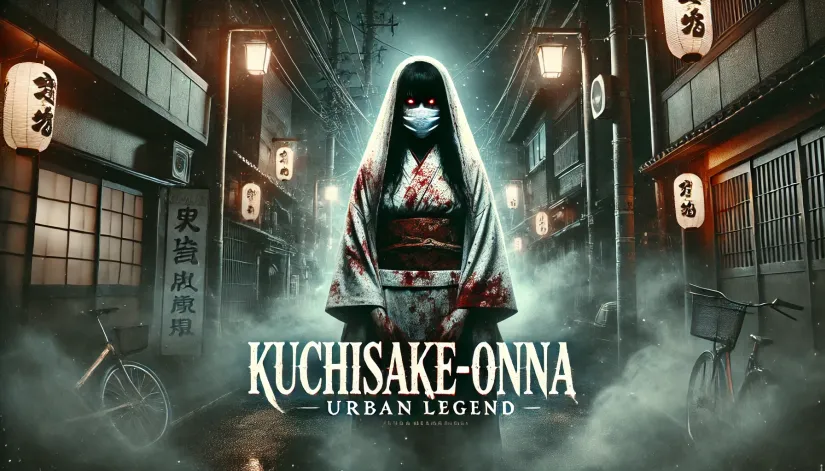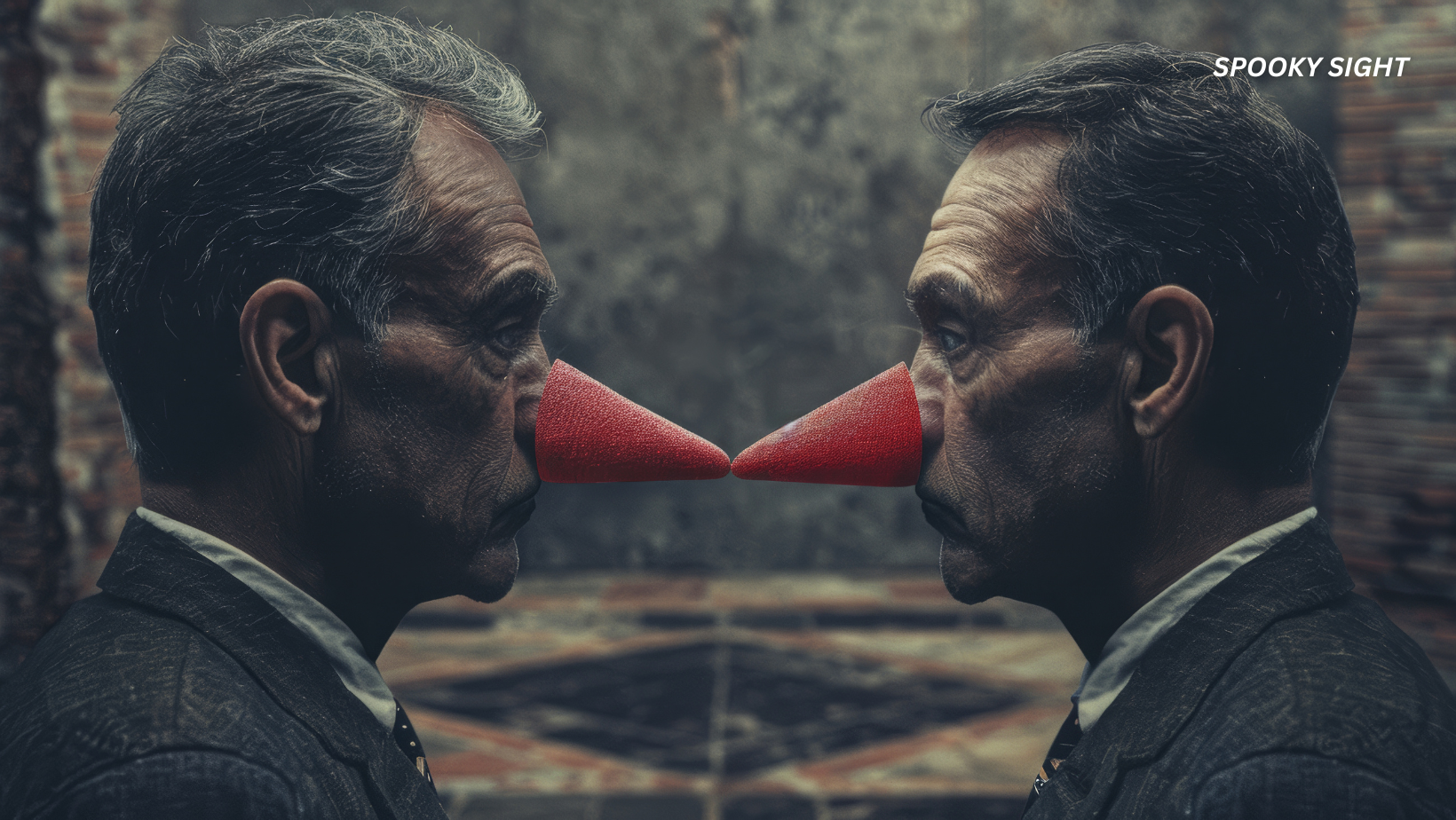When it comes to horror, Japan doesn’t mess around. Japanese urban legends are some of the darkest, creepiest, and downright terrifying stories you’ll ever hear.
The Kuchisake-onna (or the Slit-Mouthed Woman) urban legend is one such story. This dark tale has haunted Japan for generations. It all started with a jealous samurai and his unfaithful wife. However, let’s just say things got really gory, really fast.
Stick around—it’s a story you won’t forget.
In this article:

Origins of the Kuchisake-onna
The Kuchisake-onna Japanese urban legend was born during the tumultuous Edo period (1603–1868). A time of rigid hierarchy, deadly samurais, and a society obsessed with honor. Life was strict, and stepping out of line could cost you—big time.
According to this legend, a woman of unparalleled beauty lived in a small village nestled among misty mountains. Her skin was as pale as moonlight, her eyes like dark pools you could drown in, and her smile—well, that was the stuff of legends.
Men whispered about her; women envied her. She was Kuchisake, the woman who could make hearts skip a beat with just a glance.
But no one dared to approach her. There was a strange rumor in the village that she was cursed. Or hiding something dark.
One day, a powerful and brave samurai saw her while she was carrying water from a nearby well. The warrior was young and tall, with piercing eyes and dark hair.
The two fall in love immediately. They soon married, and at first, it seemed like a fairytale.
But beneath the surface, darkness brewed.
The samurai was obsessively jealous. Every laugh she shared, every glance she exchanged—it all fed his paranoia. Whispers started circulating. Some said Kuchisake was unfaithful. That she met a lover under the cloak of night. Others believed the samurai was losing his grip on reality.
One fateful evening, the samurai followed her through shadowed alleys to a secluded garden bathed in the eerie glow of lantern light. There, he saw her with another man—laughing, touching. His blood boiled.

Blinded by rage, the samurai drew his katana without a second thought. He lunged from the darkness, the blade slicing through the air with a chilling whoosh. The lover barely had time to gasp before his head was severed, blood spraying like a crimson fountain.
Kuchisake screamed, but no one heard over the pounding rain that began to fall. The samurai grabbed her by the hair, dragging her through the mud back to their home.
His grip was iron; her pleas fell on deaf ears.
Inside, he threw her to the floor. “You think you can humiliate me?” he snarled, eyes wild like a beast. Then, he pulled out a dagger, and before she could utter another word, he slit her mouth from ear to ear.
The skin tore like paper, blood gushing down her neck and soaking her kimono. Her screams turned into grotesque gurgles.
Gripped by insanity, the once brave samurai leaned in close, his breath hot against her mutilated face. “Who will think you’re beautiful now?” he hissed.
But he wasn’t done. Some say he tortured her for hours, watching the life drain from her eyes. Others whisper that he kept her alive, hidden away, suffering in endless agony.

Eventually, death came as a twisted mercy. But for Kuchisake, it was just the beginning.
Her spirit couldn’t rest. Consumed by pain, betrayal, and an insatiable thirst for revenge, she transformed into an onryō—a vengeful ghost bound to the mortal world.
She rose from the shadows, her once-beautiful face now a horrific grin carved from ear to ear. Blood still dripped from the wound that never healed. Clad in white, she roamed the streets, seeking out the unsuspecting.
Her mission? To make others feel her suffering. To share the pain etched permanently across her face. And so, the legend of the Slit-Mouthed Woman was born—a harbinger of doom lurking just beyond the flicker of the street lamps.
How Does Kuchisake-onna Look Like
So, what’s the deal with Kuchisake-onna? At first glance, she might seem like any ordinary woman you’d pass on the street. But trust me, she’s anything but ordinary.
She often appears wearing a surgical mask. In Japan, that’s not unusual—people wear masks for all sorts of reasons, like avoiding germs or pollen. This helps her blend in, making it easy to approach unsuspecting victims without raising alarm.
Behind that mask lies a horrifying secret: her mouth is slit from ear to ear, giving her a grotesque, permanent grin. The wound might be fresh and bloody, oozing crimson, or it could be a healed scar, twisted and ghastly. Either way, it’s a sight that’ll haunt your nightmares.
She’s usually described as having long, straight black hair that cascades over her shoulders, often slightly disheveled. Her skin is pale, almost ghost-like.
According to some variations of the urban legend, she may wear a red coat (or a flowing kimono), which might symbolize the blood spilled from her own wounds—or from her victims. Occasionally, she’s seen clutching a sharp object like a knife, scissors, or even a sickle.
Her eyes are another unsettling feature. They might be lifeless and cold, or sometimes described as gleaming with a malevolent light. Her movements are unnaturally silent.

Where She Wanders
Kuchisake-onna isn’t confined to one place. According to the legend, she roams various settings throughout Japan.
She often prowls quiet neighborhoods, empty alleyways, or deserted streets in cities and towns. Late at night or during foggy evenings is when she’s most active. The low visibility and the silence of these times make it easier for her to approach her victims unnoticed.
In some versions of the tale, she specifically targets children. Sightings near schools, playgrounds, or routes kids take to get home aren’t uncommon.
SpookySight recommends:
- The Smiling Man: A Terrifying Urban Legend from Seattle
- The Rake Monster: Creepypasta’s Most Terrifying Urban Legend?
- 8 Astonishing Yeti Myths You Probably Haven’t Heard Of
In the late 1970s, there were reports of a woman fitting her description seen near elementary schools, causing widespread panic among parents and educators.
Some stories place her in the countryside, appearing along lonely roads or near forests. Public parks, hospital corridors, and even shopping malls during closing hours can also be among her haunts. Basically, anywhere you might find yourself alone and vulnerable could be her hunting ground.
What to do if Kuchisake-onna Finds You?
So, let’s say you’re out and about, maybe heading home after a late shift or a night out with friends. The streets are quiet, and a slight mist hangs in the air. Suddenly, you notice a woman standing under a flickering streetlight. She seems ordinary enough, but something about her makes you uneasy.
She steps into your path as you approach. “Excuse me,” she says softly. Her voice is almost musical, yet it sends a shiver down your spine. “Am I beautiful?”
“Am I beautiful?” It’s a simple question, but it’s loaded with peril. How you respond could determine your fate.
Possible Responses and Outcomes
If you bluntly say “No,” she doesn’t take it well. In an instant, Kuchisake-onna pulls out her weapon—maybe a pair of gleaming scissors or a sharp knife—and attacks with deadly precision. It’s swift, violent, and there’s no escape. Your life ends there on the cold pavement.
If you say “Yes,” you might think you’re safe. Think again. Kuchisake-onna will remove her mask and reveal the horrifying slit across her face. The skin is torn, the flesh exposed, sometimes with the wound still bleeding.
She asks again, “How about now?” Her voice may be distorted, dripping with malice.
If you somehow manage to keep your composure and say “Yes” again, some versions of the legend say she’ll let you go. But others aren’t so forgiving—she might follow you home and attack you when you least expect it. Or give you a matching smile right then and there by slitting your mouth from ear to ear.
If you show fear, disgust, or say “No,” Kuchisake-onna doesn’t hesitate. She attacks immediately, and it’s game over.
In some accounts, trying to run away is also futile. Kuchisake-onna can be unnaturally fast and just appear ahead of you no matter which way you turn.

Survival Tactics
But don’t lose hope just yet. Over the years, people have come up with ways to escape her deadly game.
Giving an ambiguous answer like “You’re average” or “So-so” can throw Kuchisake-onna off balance. The legend says she’ll pause to contemplate your response, giving you a precious moment to slip away. Her fixation on the question’s answer means that an unexpected reply can disrupt her pattern.
Believe it or not, Kuchisake-onna has a sweet tooth. Offering her candies like bekko ame (hard caramel candies) or fruit drops might just be enough to distract her.
The deadly Slit-Mouthed Woman could accept the treat and be momentarily appeased. But not for long. Just so you can make your exit. Some say that giving her candy is a form of bribe.
Asking her a question in return, such as “Do you think I’m beautiful?” can also confuse her. While she’s contemplating, you might get the chance to escape.
Another tactic is to throw money or other objects to the ground, which might distract her enough for you to get away.
Carrying a Shinto charm or protective talisman might offer some protection. Some say repeating specific phrases like “I have a prior engagement” or “I’m in a hurry” can cause her to hesitate.
The idea is that politeness and social obligations are deeply ingrained, even in spirits.
Extra Tips for Survival
Travel in groups. Kuchisake-onna is less likely to approach if you’re not alone. Stick with friends when walking at night. There’s safety in numbers, and witnesses might deter her from making a move.
Stay in well-lit areas. She prefers dimly lit or deserted places. Keeping to well-lit, populated areas can reduce the risk of an encounter. Avoid shortcuts through alleys or isolated paths, even if it takes longer to reach your destination.
Be prepared. If you’re in Japan and aware of the legend, carrying some candies or a small charm might give you peace of mind. It might seem superstitious, but it’s better to be safe than sorry.
Finally, trust your instincts. If something feels off, it probably is. Don’t hesitate to change your route or seek help if you feel you’re being followed.

Modern Resurgence and Real-Life Incidents
The 1970s Panic in Japan
In the late 1970s, Japan was gripped by a wave of hysteria that brought the legend of Kuchisake-onna back into the limelight. Around 1979, rumors started swirling about sightings of the Slit-Mouthed Woman creeping on the streets and near schools (particularly in the Gifu and Aichi prefectures).
Unexplained incidents began to unsettle communities. Children reported being approached by a mysterious woman wearing a surgical mask. She would ask them the dreaded question: “Am I beautiful?” The fear spread faster than wildfire.
Parents were freaking out, afraid to let their kids walk home alone. Schools started taking precautions—teachers would escort students in groups, and after-school activities were cut short.
Interviews with alleged witnesses started popping up left and right. People claimed to have encountered Kuchisake-onna and lived to tell the tale. Their stories shared common threads: a woman with long black hair, a surgical mask, and that haunting question.
One kid recounted how he was walking home when a masked woman approached him. “Am I beautiful?” she asked. Remembering something he’d heard on the playground, he replied, “You’re so-so.” She paused, confused. That gave him just enough time to run away.
Ultimately, the police had to step in. Authorities increased patrols, especially around neighborhoods where sightings were reported.
While they didn’t officially acknowledge the supernatural aspect, their presence was meant to calm everyone down. But let’s be real—it only added to the buzz.
Despite these efforts, no concrete evidence of any physical person matching the descriptions was ever found. And no arrests were made directly related to the Kuchisake-onna urban legend.
There were a few isolated incidents, such as a woman in Himeji City who was brought in for questioning for walking around with a knife while dressed as Kuchisake-onna as part of a prank.
The police treated these occurrences as pranks or mass hysteria. And the panic gradually subsided as the summer holidays began, with children no longer congregating in schools to spread the rumors.

2004 South Korea Sightings
The legend didn’t stay put in Japan. In 2004, reports appeared from South Korea about sightings of a similar figure. The reports were followed by a series of unsettling incidents in a public park that reignited fears.
What happened? Several mutilated bodies were discovered. And whispers of Kuchisake-onna started making the rounds.
A couple witnesses described seeing a woman wearing a red surgical mask—a detail that matched the Japanese legend. However, these reports were treated as part of a mass hysteria phenomenon rather than linked to the actual murders.
Kuchisake-onna vs. Other Urban Legends
Teke Teke“ is another horrifying Japanese urban legend about a woman who fell onto a railway line and was cut in half by an oncoming train.
Now, as a vengeful spirit, she drags her upper torso using her elbows, producing an eerie “teke teke” sound. If she catches you, she’ll slice you in half, mimicking her own gruesome fate.
Then there’s “Hanako-san,” the ghost of a young girl who haunts school bathrooms.
The story goes that if you knock three times on the third stall in a girls’ restroom and ask, “Are you there, Hanako-san?” you might hear a faint reply. If you’re unlucky, she’ll pull you into the toilet, and you’ll never be seen again.
The Red Room Curse“ is a modern Japanese urban legend spread online. It involves an unexplainable pop-up on your computer screen with a simple question: “Do you like the red room?”
Those who see it are said to be found dead, their walls painted with their own blood.
Looking beyond Japan, many cultures have spine-chilling urban legends and horror stories that share similarities with Kuchisake-onna.
“Bloody Mary” is probably one of the best-known Western urban legends. Chant her name three times in front of a mirror, and she might just appear behind you. Often with malevolent intentions.
Like Kuchisake-onna, summoning her is tied to vanity and curiosity, with dire consequences.
Finally, “La Llorona” (the Weeping Woman) is a Latin American horror story. She’s said to roam near rivers and lakes, mourning her drowned children whom she killed in a fit of madness. Encountering her can be deadly, especially for children who wander alone at night.
Symbolism and Cultural Interpretations
The Kuchisake-onna Japanese urban legend isn’t just a creepy tale to make you check over your shoulder—it’s filled with powerful symbolism and valuable teachings.
Jealousy and Betrayal
First off, let’s talk about samurai honor. In feudal Japan, samurais were more than common warriors. They were bound by a strict code called Bushido. It was a code of loyalty, honor, and discipline.
The extreme actions taken by the samurai husband in the legend highlight the lengths to which one might go to preserve personal and familial honor. Infidelity was more than a personal slight—it was a stain on one’s reputation that could ripple through generations.
This leads to the consequences of infidelity. The brutal punishment inflicted on Kuchisake-onna mirrors societal views on loyalty and the severe repercussions of betrayal.
Obsession with Beauty
Society’s fixation on physical appearance is another essential part of the legend.
The pressure to conform to certain beauty standards isn’t a new phenomenon. Physical appearance in society has always held significant weight, influencing social status and personal worth.
Kuchisake-onna’s beauty was her greatest asset and her downfall, making her a target of desire and jealousy.
So, the act of disfigurement as punishment is symbolic. By mutilating her face, the samurai caused her physical harm. That’s for sure. But he was also stripping away her societal value.
Fear of Retribution
The legend also taps into the universal concept of karma and the idea that our actions have consequences.
In fact, karma and vengeance play a significant role here. The samurai’s heinous act didn’t go unpunished. Instead, it birthed a vengeful spirit that terrorizes the living. It’s a manifestation of the belief that wrongful actions invite dire repercussions, sometimes extending beyond the grave.
Moral Lessons
At its core, the Kuchisake-onna urban legend is a moral lesson. It warns against deceit, which is evident. Infidelity and dishonesty dangers are highlighted, warning people about the potential fallout of their actions—not just on themselves but others around them.
Then there’s the price of obsession. The samurai’s overwhelming jealousy and need for control led to unimaginable horror. It’s a powerful lesson about how unchecked emotions can spiral into destructive behavior.







